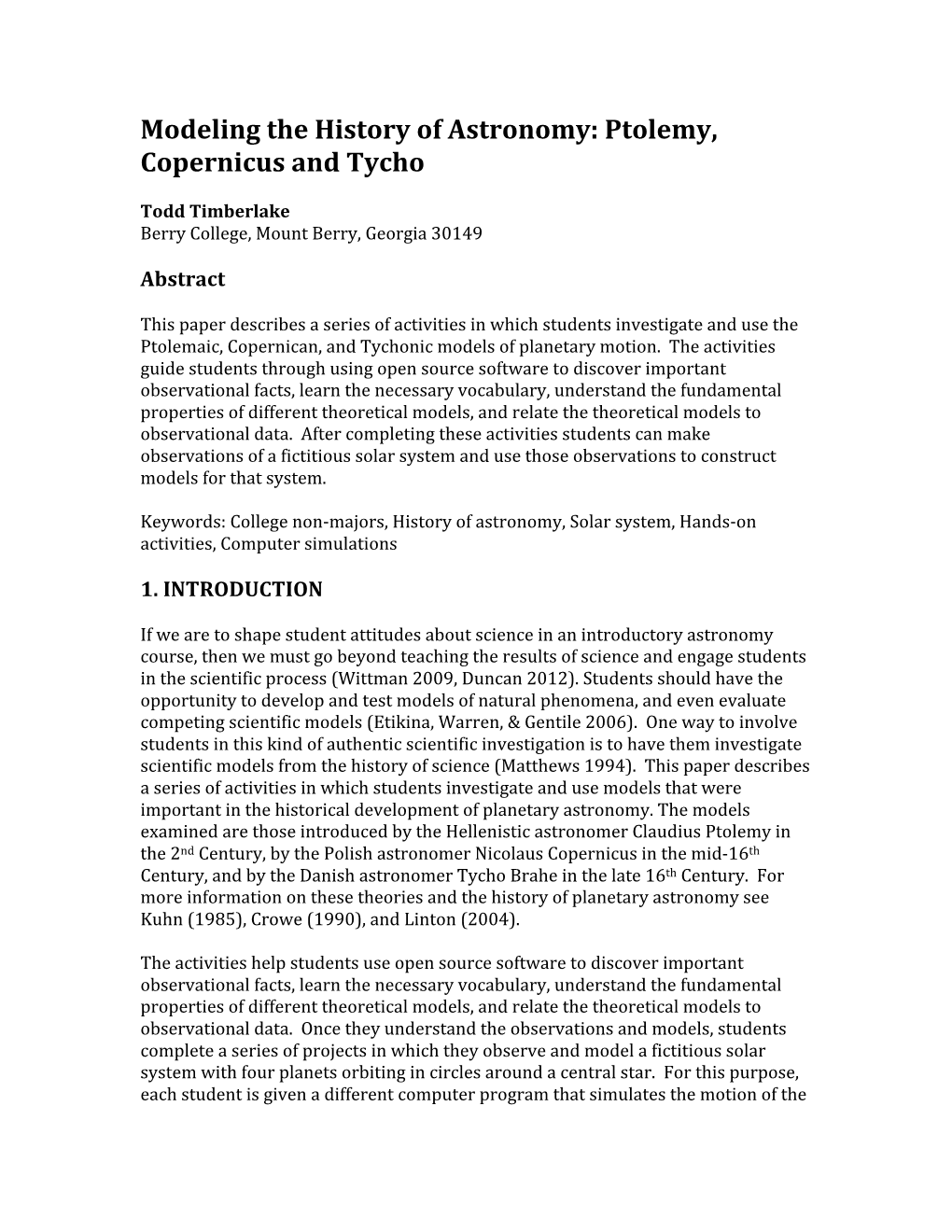ModelingꢀtheꢀHistoryꢀofꢀAstronomy:ꢀPtolemy,ꢀ
CopernicusꢀandꢀTychoꢀ
ꢀ
ToddꢀTimberlakeꢀ
BerryꢀCollege,ꢀMountꢀBerry,ꢀGeorgiaꢀ30149ꢀ
ꢀ
Abstractꢀ
ꢀ
Thisꢀpaperꢀdescribesꢀaꢀseriesꢀofꢀactivitiesꢀinꢀwhichꢀstudentsꢀinvestigateꢀandꢀuseꢀtheꢀ
Ptolemaic,ꢀCopernican,ꢀandꢀTychonicꢀmodelsꢀofꢀplanetaryꢀmotion.ꢀꢀTheꢀactivitiesꢀ guideꢀstudentsꢀthroughꢀusingꢀopenꢀsourceꢀsoftwareꢀtoꢀdiscoverꢀimportantꢀ observationalꢀfacts,ꢀlearnꢀtheꢀnecessaryꢀvocabulary,ꢀunderstandꢀtheꢀfundamentalꢀ propertiesꢀofꢀdifferentꢀtheoreticalꢀmodels,ꢀandꢀrelateꢀtheꢀtheoreticalꢀmodelsꢀtoꢀ observationalꢀdata.ꢀꢀAfterꢀcompletingꢀtheseꢀactivitiesꢀstudentsꢀcanꢀmakeꢀ observationsꢀofꢀaꢀfictitiousꢀsolarꢀsystemꢀandꢀuseꢀthoseꢀobservationsꢀtoꢀconstructꢀ modelsꢀforꢀthatꢀsystem.ꢀꢀ
ꢀ
Keywords:ꢀCollegeꢀnon-majors,ꢀHistoryꢀofꢀastronomy,ꢀSolarꢀsystem,ꢀHands-onꢀ activities,ꢀComputerꢀsimulationsꢀ
ꢀ
1.ꢀINTRODUCTIONꢀ
ꢀ
Ifꢀweꢀareꢀtoꢀshapeꢀstudentꢀattitudesꢀaboutꢀscienceꢀinꢀanꢀintroductoryꢀastronomyꢀ course,ꢀthenꢀweꢀmustꢀgoꢀbeyondꢀteachingꢀtheꢀresultsꢀofꢀscienceꢀandꢀengageꢀstudentsꢀ inꢀtheꢀscientificꢀprocessꢀ(Wittmanꢀ2009,ꢀDuncanꢀ2012).ꢀStudentsꢀshouldꢀhaveꢀtheꢀ opportunityꢀtoꢀdevelopꢀandꢀtestꢀmodelsꢀofꢀnaturalꢀphenomena,ꢀandꢀevenꢀevaluateꢀ competingꢀscientificꢀmodelsꢀ(Etikina,ꢀWarren,ꢀ ꢀGentileꢀ2006).ꢀꢀOneꢀwayꢀtoꢀinvolveꢀ studentsꢀinꢀthisꢀkindꢀofꢀauthenticꢀscientificꢀinvestigationꢀisꢀtoꢀhaveꢀthemꢀinvestigateꢀ scientificꢀmodelsꢀfromꢀtheꢀhistoryꢀofꢀscienceꢀ(Matthewsꢀ1994).ꢀꢀThisꢀpaperꢀdescribesꢀ aꢀseriesꢀofꢀactivitiesꢀinꢀwhichꢀstudentsꢀinvestigateꢀandꢀuseꢀmodelsꢀthatꢀwereꢀ importantꢀinꢀtheꢀhistoricalꢀdevelopmentꢀofꢀplanetaryꢀastronomy.ꢀTheꢀmodelsꢀ examinedꢀareꢀthoseꢀintroducedꢀbyꢀtheꢀHellenisticꢀastronomerꢀClaudiusꢀPtolemyꢀinꢀ theꢀ2ndꢀCentury,ꢀbyꢀtheꢀPolishꢀastronomerꢀNicolausꢀCopernicusꢀinꢀtheꢀmid-16thꢀ
Century,ꢀandꢀbyꢀtheꢀDanishꢀastronomerꢀTychoꢀBraheꢀinꢀtheꢀlateꢀ16thꢀCentury.ꢀꢀForꢀ moreꢀinformationꢀonꢀtheseꢀtheoriesꢀandꢀtheꢀhistoryꢀofꢀplanetaryꢀastronomyꢀseeꢀ
Kuhnꢀ(1985),ꢀCroweꢀ(1990),ꢀandꢀLintonꢀ(2004).ꢀ
ꢀ
Theꢀactivitiesꢀhelpꢀstudentsꢀuseꢀopenꢀsourceꢀsoftwareꢀtoꢀdiscoverꢀimportantꢀ observationalꢀfacts,ꢀlearnꢀtheꢀnecessaryꢀvocabulary,ꢀunderstandꢀtheꢀfundamentalꢀ propertiesꢀofꢀdifferentꢀtheoreticalꢀmodels,ꢀandꢀrelateꢀtheꢀtheoreticalꢀmodelsꢀtoꢀ observationalꢀdata.ꢀꢀOnceꢀtheyꢀunderstandꢀtheꢀobservationsꢀandꢀmodels,ꢀstudentsꢀ completeꢀaꢀseriesꢀofꢀprojectsꢀinꢀwhichꢀtheyꢀobserveꢀandꢀmodelꢀaꢀfictitiousꢀsolarꢀ systemꢀwithꢀfourꢀplanetsꢀorbitingꢀinꢀcirclesꢀaroundꢀaꢀcentralꢀstar.ꢀꢀForꢀthisꢀpurpose,ꢀ eachꢀstudentꢀisꢀgivenꢀaꢀdifferentꢀcomputerꢀprogramꢀthatꢀsimulatesꢀtheꢀmotionꢀofꢀtheꢀ centralꢀstarꢀandꢀthreeꢀplanetsꢀ(oneꢀofꢀtheꢀfourꢀplanetsꢀisꢀtheꢀobserver’sꢀhomeꢀplanet)ꢀ againstꢀaꢀfixedꢀbackgroundꢀofꢀstars.ꢀꢀMostꢀofꢀtheꢀcomputerꢀsimulationsꢀwereꢀcreatedꢀ withꢀEasyꢀJavaꢀSimulationsꢀ(Esquembreꢀ2013)ꢀandꢀareꢀpartꢀofꢀtheꢀOpenꢀSourceꢀ
Physicsꢀcollectionꢀ(OpenꢀSourceꢀPhysicsꢀ2013).ꢀꢀAllꢀofꢀtheꢀcomputerꢀsimulations,ꢀ activityꢀhandouts,ꢀandꢀprojectꢀmaterialsꢀhaveꢀbeenꢀcollectedꢀinꢀaꢀsharedꢀfolderꢀinꢀtheꢀ
OpenꢀSourceꢀPhysicsꢀcollectionꢀonꢀtheꢀComPADREꢀꢀdigitalꢀarchiveꢀ(Timberlakeꢀ2013).ꢀ
ꢀ
ꢀ
2.ꢀOBSERVINGꢀTHEꢀSKYꢀ
ꢀ
TheꢀPtolemaic,ꢀCopernicanꢀandꢀTychonicꢀtheoriesꢀwereꢀattemptsꢀtoꢀmodelꢀnakedeyeꢀobservationsꢀofꢀtheꢀnightꢀsky.ꢀꢀBeforeꢀexploringꢀtheseꢀtheories,ꢀstudentsꢀmakeꢀꢀꢀꢀ simulatedꢀobservationsꢀ(bothꢀqualitativeꢀandꢀquantitative)ꢀofꢀtheꢀnightꢀskyꢀusingꢀtheꢀ open-sourceꢀplanetariumꢀprogramꢀStellariumꢀ(Stellariumꢀ2013).ꢀ
ꢀ
Observationsꢀofꢀtheꢀstarsꢀleadꢀstudentsꢀtoꢀtheirꢀfirstꢀastronomicalꢀmodel:ꢀtheꢀ
CelestialꢀSphere.ꢀꢀTheꢀstarsꢀappearꢀtoꢀmoveꢀasꢀthoughꢀtheyꢀareꢀstuckꢀonꢀtheꢀsurfaceꢀofꢀ aꢀgiantꢀsphereꢀwithꢀEarthꢀatꢀtheꢀcenter.ꢀꢀTheꢀCelestialꢀSphereꢀrotatesꢀeastꢀtoꢀwestꢀ onceꢀeveryꢀsiderealꢀdayꢀ(23ꢀhours,ꢀ56ꢀminutes)ꢀaboutꢀaꢀfixedꢀaxis.ꢀꢀForꢀtheꢀpurposeꢀ ofꢀexaminingꢀtheꢀmotionsꢀofꢀallꢀotherꢀcelestialꢀbodies,ꢀtheꢀCelestialꢀSphereꢀcanꢀbeꢀ usedꢀasꢀaꢀfixedꢀbackground.ꢀꢀForꢀexample,ꢀstudentsꢀdiscoverꢀthatꢀtheꢀSunꢀdriftsꢀ roughlyꢀeastwardꢀrelativeꢀtoꢀtheꢀCelestialꢀSphereꢀalongꢀaꢀgreatꢀcircleꢀpathꢀknownꢀasꢀ theꢀEcliptic.ꢀꢀAsꢀaꢀresultꢀofꢀthisꢀdriftꢀitꢀtakesꢀslightlyꢀlongerꢀ(24ꢀhours,ꢀorꢀoneꢀsolarꢀ day)ꢀforꢀtheꢀSunꢀtoꢀcompleteꢀaꢀfullꢀrotationꢀinꢀourꢀsky,ꢀandꢀtheꢀSunꢀcompletesꢀoneꢀfullꢀ circuitꢀalongꢀtheꢀEclipticꢀinꢀaꢀsiderealꢀyearꢀ(aboutꢀ365.25ꢀsolarꢀdays).ꢀ
ꢀ
Studentsꢀthenꢀobserveꢀtheꢀfiveꢀvisibleꢀplanets:ꢀMercury,ꢀVenus,ꢀMars,ꢀJupiter,ꢀandꢀ
Saturn.ꢀꢀTheyꢀfindꢀthatꢀallꢀfiveꢀplanetsꢀmoveꢀrelativeꢀtoꢀtheꢀCelestialꢀSphere.ꢀꢀTheꢀ planetsꢀmoveꢀgenerallyꢀeastwardꢀandꢀremainꢀnearꢀtheꢀEcliptic,ꢀalthoughꢀtheyꢀcanꢀbeꢀ aboveꢀorꢀbelow.ꢀꢀTheꢀaverageꢀtimeꢀforꢀaꢀplanetꢀtoꢀcompleteꢀoneꢀcircuitꢀalongꢀtheꢀ
Eclipticꢀisꢀtheꢀplanet’sꢀzodiacalꢀperiod.ꢀꢀPlanetsꢀalsoꢀmoveꢀrelativeꢀtoꢀtheꢀSun.ꢀꢀTheꢀ elongationꢀofꢀaꢀplanetꢀisꢀtheꢀangleꢀbetweenꢀtheꢀplanetꢀandꢀtheꢀSunꢀonꢀtheꢀsky.ꢀꢀIfꢀaꢀ planetꢀisꢀatꢀ0°ꢀelongationꢀitꢀisꢀsaidꢀtoꢀbeꢀinꢀconjunction,ꢀatꢀ90°ꢀitꢀisꢀinꢀquadrature,ꢀandꢀ atꢀ180°ꢀitꢀisꢀinꢀopposition.ꢀꢀTheꢀSunꢀperiodicallyꢀmovesꢀeastwardꢀpastꢀeachꢀplanetꢀ andꢀtheꢀtimeꢀbetweenꢀoneꢀpassꢀandꢀtheꢀnextꢀisꢀthatꢀplanet’sꢀsynodicꢀperiod.ꢀꢀStudentsꢀ areꢀoftenꢀsurprisedꢀtoꢀdiscoverꢀthatꢀtheꢀplanetsꢀoccasionallyꢀmoveꢀwestwardꢀforꢀaꢀ shortꢀtime,ꢀinꢀwhatꢀisꢀcalledꢀretrogradeꢀmotion,ꢀbeforeꢀresumingꢀtheirꢀeastwardꢀ motion.ꢀꢀTheꢀtimeꢀbetweenꢀsuccessiveꢀretrogradesꢀisꢀobservedꢀtoꢀbeꢀequalꢀtoꢀtheꢀ planet’sꢀsynodicꢀperiod.ꢀꢀꢀ
ꢀ
Inꢀspiteꢀofꢀtheseꢀgeneralꢀcharacteristics,ꢀnotꢀallꢀplanetsꢀbehaveꢀtheꢀsame.ꢀꢀMercuryꢀ andꢀVenusꢀareꢀneverꢀmoreꢀthanꢀ28°ꢀandꢀ48°,ꢀrespectively,ꢀfromꢀtheꢀSun.ꢀꢀTheyꢀareꢀinꢀ conjunctionꢀduringꢀtheꢀmiddleꢀofꢀtheirꢀretrogradeꢀmotion.ꢀꢀTheseꢀplanetsꢀareꢀknownꢀ asꢀinferiorꢀplanets.ꢀꢀMars,ꢀJupiter,ꢀandꢀSaturnꢀcanꢀattainꢀanyꢀelongation.ꢀꢀTheyꢀareꢀinꢀ oppositionꢀduringꢀtheꢀmiddleꢀofꢀtheirꢀretrogradeꢀmotion.ꢀꢀTheseꢀplanetsꢀareꢀknownꢀ asꢀsuperiorꢀplanets.ꢀꢀAllꢀplanetsꢀappearꢀsomewhatꢀbrighterꢀduringꢀretrograde,ꢀbutꢀ
Marsꢀdisplaysꢀtheꢀgreatestꢀincreaseꢀinꢀbrightness.ꢀ
ꢀ
Afterꢀexploringꢀandꢀmeasuringꢀtheꢀrealꢀ(simulated)ꢀnightꢀsky,ꢀstudentsꢀmakeꢀ observationsꢀofꢀtheꢀnightꢀskyꢀinꢀtheirꢀpersonalizedꢀsolarꢀsystem.ꢀꢀStudentsꢀmustꢀ determineꢀtheꢀnumberꢀofꢀplanetsꢀandꢀclassifyꢀeachꢀplanetꢀasꢀinferiorꢀorꢀsuperior.ꢀꢀ
Theyꢀmustꢀmeasureꢀtheꢀsiderealꢀyearꢀ(Tsy),ꢀasꢀwellꢀasꢀtheꢀzodiacalꢀperiodꢀ(Tz)ꢀandꢀ synodicꢀperiodꢀ(Ts)ꢀofꢀeachꢀplanet.ꢀꢀTheyꢀmustꢀmeasureꢀtheꢀmaximumꢀelongationꢀ(α)ꢀ ofꢀeachꢀinferiorꢀplanetꢀandꢀtheꢀtimeꢀfromꢀoppositionꢀtoꢀquadratureꢀ(tQ)ꢀforꢀeachꢀ superiorꢀplanet.ꢀꢀTheseꢀmeasurementsꢀwillꢀbeꢀusedꢀlaterꢀtoꢀconstructꢀmodelsꢀofꢀtheirꢀ solarꢀsystem.ꢀ
ꢀ
3.ꢀPTOLEMAICꢀMODELINGꢀ
ꢀ
TheꢀnextꢀsetꢀofꢀactivitiesꢀhelpsꢀstudentsꢀexploreꢀaꢀsimplifiedꢀversionꢀofꢀPtolemy’sꢀ modelꢀforꢀplanetaryꢀmotionsꢀusingꢀtheꢀInferiorꢀPtolemaicꢀandꢀSuperiorꢀPtolemaicꢀEJSꢀ programsꢀ(Timberlakeꢀ2013).ꢀꢀInꢀtheꢀsimplifiedꢀPtolemaicꢀmodelꢀeachꢀplanetꢀmovesꢀ uniformlyꢀcounterclockwiseꢀonꢀaꢀcircleꢀcalledꢀtheꢀepicycleꢀwhileꢀtheꢀcenterꢀofꢀtheꢀ epicycleꢀmovesꢀuniformlyꢀcounterclockwiseꢀalongꢀtheꢀdeferent,ꢀaꢀlargerꢀcircleꢀ centeredꢀonꢀEarth.ꢀTheꢀSunꢀmovesꢀuniformlyꢀcounterclockwiseꢀalongꢀaꢀcircleꢀ centeredꢀonꢀEarth.1ꢀ
ꢀ
ByꢀworkingꢀwithꢀtheꢀsimulationsꢀstudentsꢀdiscoverꢀthatꢀtheꢀperiodꢀofꢀtheꢀSun’sꢀorbitꢀ mustꢀequalꢀtheꢀsiderealꢀyear.ꢀꢀTheyꢀfindꢀthatꢀplanetsꢀretrogradeꢀwhenꢀtheꢀmotionꢀofꢀ theꢀplanetꢀalongꢀtheꢀepicycleꢀisꢀinꢀtheꢀoppositeꢀdirectionꢀofꢀtheꢀmotionꢀofꢀtheꢀ epicycleꢀcenterꢀalongꢀtheꢀdeferent,ꢀwhichꢀoccursꢀwhenꢀtheꢀplanetꢀisꢀonꢀtheꢀ innermostꢀpartꢀofꢀtheꢀepicycle.ꢀꢀTheꢀperiodꢀofꢀtheꢀepicycleꢀcenter’sꢀmotionꢀaroundꢀ theꢀdeferentꢀmustꢀequalꢀtheꢀplanet’sꢀzodiacalꢀperiod.ꢀꢀIfꢀtheꢀperiodꢀofꢀtheꢀplanet’sꢀ motionꢀaroundꢀtheꢀepicycleꢀisꢀmeasuredꢀrelativeꢀtoꢀtheꢀdeferentꢀ(soꢀthatꢀaꢀfullꢀperiodꢀ isꢀmeasuredꢀfromꢀtheꢀtimeꢀtheꢀplanetꢀcrossesꢀtheꢀdeferentꢀcircleꢀgoingꢀoutwardꢀuntilꢀ theꢀnextꢀtimeꢀitꢀdoesꢀso)ꢀthenꢀthisꢀepicycleꢀperiodꢀmustꢀequalꢀtheꢀplanet’sꢀsynodicꢀ period.ꢀꢀꢀ
ꢀ
StudentsꢀalsoꢀdiscoverꢀtheꢀmainꢀdifferenceꢀbetweenꢀtheꢀPtolemaicꢀtheoriesꢀforꢀ inferiorꢀandꢀsuperiorꢀplanets.ꢀꢀTheꢀcenterꢀofꢀanꢀinferiorꢀplanet’sꢀepicycleꢀmustꢀ remainꢀonꢀtheꢀEarth-SunꢀlineꢀinꢀorderꢀtoꢀkeepꢀtheꢀplanetꢀnearꢀtheꢀSunꢀinꢀtheꢀsky.ꢀꢀForꢀ superiorꢀplanets,ꢀonꢀtheꢀotherꢀhand,ꢀtheꢀlineꢀfromꢀtheꢀcenterꢀofꢀtheꢀepicycleꢀtoꢀtheꢀ planetꢀmustꢀalwaysꢀbeꢀparallelꢀtoꢀtheꢀEarth-Sunꢀlineꢀinꢀorderꢀtoꢀensureꢀthatꢀtheꢀ planetꢀalwaysꢀretrogradesꢀatꢀopposition.ꢀ
ꢀꢀꢀꢀꢀꢀꢀꢀꢀꢀꢀꢀꢀꢀꢀꢀꢀꢀꢀꢀꢀꢀꢀꢀꢀꢀꢀꢀꢀꢀꢀꢀꢀꢀꢀꢀꢀꢀꢀꢀꢀꢀꢀꢀꢀꢀꢀꢀꢀꢀꢀꢀꢀꢀꢀꢀ
1ꢀInꢀtheꢀfullꢀPtolemaicꢀmodelꢀtheꢀSun’sꢀorbitꢀandꢀtheꢀdeferentꢀcirclesꢀwereꢀnotꢀ centeredꢀonꢀEarth,ꢀandꢀtheꢀepicycleꢀcentersꢀdidꢀnotꢀmoveꢀuniformlyꢀalongꢀtheꢀ deferent.ꢀꢀTheꢀtheoriesꢀforꢀMercuryꢀandꢀVenusꢀhadꢀadditionalꢀcomplications.ꢀ Studentsꢀcanꢀalsoꢀdetermineꢀtheꢀrelativeꢀsizesꢀofꢀeachꢀplanet’sꢀepicycleꢀandꢀdeferent.ꢀꢀ
Forꢀanꢀinferiorꢀplanet,ꢀtheꢀratioꢀofꢀitsꢀepicycleꢀradiusꢀtoꢀitsꢀdeferentꢀradiusꢀisꢀgivenꢀ byꢀ
Re
= sinα ,ꢀ
ꢀꢀꢀ ꢀꢀꢀꢀꢀꢀꢀ ꢀꢀ(1)ꢀ
Rd whereꢀαꢀisꢀtheꢀplanet’sꢀmaximumꢀelongation,ꢀasꢀshownꢀinꢀFigureꢀ1.ꢀꢀꢀ
ꢀ
Re
↵
Rd
ꢀ
Figure 1: Ptolemaic geometry for an inferior planet at maximum elongation. Note that the center of the epicycle lies on the Earth-Sun line.
ꢀ
Forꢀaꢀsuperiorꢀplanetꢀthisꢀratioꢀcanꢀbeꢀcomputedꢀbyꢀcomparingꢀtheꢀgeometriesꢀatꢀ oppositionꢀandꢀatꢀquadrature,ꢀasꢀshownꢀinꢀFigureꢀ2.ꢀꢀTheꢀresultꢀlooksꢀveryꢀsimilarꢀtoꢀ
Equationꢀ1:ꢀ
Re
= sinθ ,ꢀ
ꢀꢀꢀꢀꢀ(2)ꢀ
Rd butꢀnoteꢀthatꢀαꢀꢀhasꢀbeenꢀreplacedꢀbyꢀθ,ꢀanꢀangleꢀthatꢀisꢀnotꢀobservableꢀ(becauseꢀ thereꢀisꢀnothingꢀvisibleꢀatꢀtheꢀcenterꢀofꢀtheꢀepicycle).ꢀꢀByꢀexaminingꢀtheꢀchangeꢀ betweenꢀoppositionꢀandꢀquadrature,ꢀandꢀrecallingꢀthatꢀallꢀmotionsꢀareꢀuniform,ꢀ studentsꢀcanꢀshowꢀthatꢀ ꢀθ = 90°+360° −360° ,ꢀ ꢀ ꢀꢀꢀ(3)ꢀ
Tz Tsy tQ tQ
withꢀsymbolsꢀdefinedꢀasꢀabove.ꢀ ꢀ
✓
Rd
Re
Figureꢀ2:ꢀPtolemaicꢀgeometryꢀforꢀaꢀsuperiorꢀplanetꢀatꢀoppositionꢀ(left)ꢀandꢀatꢀ easternꢀquadratureꢀ(right).ꢀꢀNoteꢀthatꢀtheꢀlineꢀfromꢀtheꢀcenterꢀofꢀtheꢀepicycleꢀtoꢀtheꢀ planetꢀisꢀalwaysꢀparallelꢀtoꢀtheꢀEarth-Sunꢀline.ꢀ
ꢀ
AfterꢀexploringꢀtheꢀsimplifiedꢀPtolemaicꢀmodelꢀofꢀourꢀsolarꢀsystem,ꢀstudentsꢀcanꢀ developꢀaꢀPtolemaicꢀmodelꢀforꢀtheirꢀpersonalizedꢀfictitiousꢀsolarꢀsystemꢀusingꢀtheꢀ observationalꢀdataꢀtheyꢀcollectedꢀearlier.ꢀꢀStudentsꢀalsoꢀareꢀinꢀaꢀpositionꢀtoꢀevaluateꢀ
Ptolemy’sꢀtheory.ꢀꢀTheꢀmodelꢀmatchesꢀtheꢀobservationalꢀdataꢀbothꢀqualitativelyꢀand,ꢀ toꢀsomeꢀextent,ꢀquantitatively.ꢀꢀInꢀparticular,ꢀtheꢀmodelꢀcanꢀreproduceꢀretrogradeꢀ motionꢀandꢀitꢀautomaticallyꢀmakesꢀplanetsꢀbrighterꢀduringꢀretrogradeꢀbecauseꢀtheyꢀ areꢀcloserꢀtoꢀEarthꢀatꢀthatꢀtime.ꢀꢀHowever,ꢀthereꢀareꢀalsoꢀsomeꢀoddꢀfeaturesꢀofꢀtheꢀ model.ꢀꢀRetrogradeꢀcanꢀbeꢀsynchronizedꢀtoꢀopposition/conjunctionꢀonlyꢀbyꢀaddingꢀ theꢀsomewhatꢀmysteriousꢀconstraintsꢀdescribedꢀabove.ꢀꢀNoꢀexplanationꢀisꢀofferedꢀ forꢀwhyꢀplanetsꢀcomeꢀinꢀtwoꢀdifferentꢀtypes,ꢀwithꢀdifferentꢀmotionsꢀforꢀeachꢀtype.ꢀꢀꢀ
Althoughꢀtheꢀratioꢀofꢀaꢀplanet’sꢀepicycleꢀtoꢀitsꢀdeferentꢀisꢀfixed,ꢀthereꢀisꢀnoꢀsetꢀscaleꢀ forꢀrelatingꢀtheꢀsizeꢀofꢀoneꢀplanet’sꢀorbitꢀtoꢀanother.ꢀꢀThus,ꢀevenꢀtheꢀorderꢀofꢀtheꢀ planetsꢀisꢀnotꢀdeterminedꢀinꢀtheꢀPtolemaicꢀsystem.ꢀ
ꢀ
ꢀ
4.ꢀCOPERNICANꢀMODELINGꢀ
ꢀ
InꢀtheꢀnextꢀsetꢀofꢀactivitiesꢀstudentsꢀuseꢀtheꢀCopernicanꢀSystemꢀEJSꢀprogramꢀ
(Timberlakeꢀ2013)ꢀtoꢀexploreꢀaꢀsimplifiedꢀversionꢀofꢀtheꢀCopernicanꢀtheoryꢀinꢀwhichꢀ eachꢀplanetꢀmovesꢀuniformlyꢀcounterclockwiseꢀonꢀaꢀcircleꢀcenteredꢀonꢀtheꢀSun.2ꢀ
StudentsꢀdiscoverꢀthatꢀtheꢀEarth,ꢀnowꢀtreatedꢀasꢀaꢀplanetꢀthatꢀrotatesꢀtoꢀproduceꢀtheꢀ apparentꢀrotationꢀofꢀtheꢀCelestialꢀSphere,ꢀmustꢀhaveꢀanꢀorbitalꢀperiodꢀTEꢀthatꢀisꢀ
ꢀꢀꢀꢀꢀꢀꢀꢀꢀꢀꢀꢀꢀꢀꢀꢀꢀꢀꢀꢀꢀꢀꢀꢀꢀꢀꢀꢀꢀꢀꢀꢀꢀꢀꢀꢀꢀꢀꢀꢀꢀꢀꢀꢀꢀꢀꢀꢀꢀꢀꢀꢀꢀꢀꢀꢀ
2ꢀInꢀtheꢀfullꢀCopernicanꢀsystemꢀplanetsꢀmovedꢀonꢀsmallꢀepicyclesꢀwhichꢀinꢀturnꢀ movedꢀuniformlyꢀonꢀcircularꢀorbitsꢀthatꢀwereꢀnotꢀcenteredꢀonꢀtheꢀSun.ꢀꢀTheseꢀsmallꢀ epicyclesꢀeffectivelyꢀreproducedꢀtheꢀnon-uniformꢀmotionꢀofꢀtheꢀPtolemaicꢀsystem.ꢀꢀ
TheꢀtheoriesꢀforꢀMercuryꢀandꢀVenusꢀhadꢀadditionalꢀcomplications.ꢀ equalꢀtoꢀoneꢀsiderealꢀyear.ꢀꢀTheyꢀfindꢀthatꢀallꢀotherꢀplanetsꢀareꢀnaturallyꢀclassifiedꢀasꢀ inferiorꢀorꢀsuperiorꢀdependingꢀonꢀwhetherꢀtheirꢀorbitꢀisꢀsmallerꢀorꢀlargerꢀthanꢀ
Earth’s,ꢀrespectively.ꢀTheꢀsimulationsꢀhelpꢀstudentsꢀdiscoverꢀaꢀformulaꢀforꢀtheꢀ periodꢀTpꢀofꢀaꢀplanet’sꢀorbit:ꢀ
T = T−1 ±T−1 −1 ,ꢀ
ꢀꢀꢀꢀꢀ(4)ꢀ
(
)pEs
ꢀwhereꢀTsꢀisꢀtheꢀplanet’sꢀsynodicꢀperiodꢀ(+ꢀforꢀinferior,ꢀ-ꢀforꢀsuperior).ꢀ
ꢀ
Studentsꢀalsoꢀfindꢀthatꢀtheꢀrelativeꢀsizesꢀofꢀallꢀplanetaryꢀorbitsꢀcanꢀbeꢀdeterminedꢀ fromꢀobservations.ꢀꢀTheꢀratioꢀofꢀtheꢀorbitalꢀradiusꢀRIꢀforꢀanꢀinferiorꢀplanetꢀtoꢀtheꢀ orbitalꢀradiusꢀREꢀofꢀEarthꢀisꢀgivenꢀbyꢀꢀ
RI
= sinα ,ꢀ
ꢀꢀꢀꢀꢀꢀ(5)ꢀ
RE whereꢀαꢀisꢀtheꢀplanet’sꢀmaximumꢀelongationꢀasꢀshownꢀinꢀFigureꢀ3.ꢀꢀꢀ
ꢀ
RI
RE
↵
ꢀ
Figureꢀ3:ꢀꢀCopernicanꢀgeometryꢀforꢀanꢀinferiorꢀplanetꢀatꢀmaximumꢀelongation.ꢀ
ꢀ
Onceꢀagainꢀtheꢀformulaꢀisꢀmoreꢀcomplicatedꢀforꢀsuperiorꢀplanets.ꢀꢀTheꢀgeometryꢀatꢀ quadratureꢀ(Figureꢀ4)ꢀshowsꢀthatꢀ
RE
= sinθ ,ꢀ
ꢀꢀꢀꢀꢀꢀ(6)ꢀ
RS whereꢀRSꢀisꢀtheꢀradiusꢀofꢀtheꢀsuperiorꢀplanet’sꢀorbitꢀandꢀθꢀisꢀanꢀangleꢀthatꢀcannotꢀbeꢀ measuredꢀdirectlyꢀfromꢀEarthꢀ(itꢀisꢀactuallyꢀtheꢀmaximumꢀelongationꢀofꢀEarthꢀasꢀ seenꢀfromꢀMars).ꢀꢀAsꢀinꢀtheꢀPtolemaicꢀsystem,ꢀstudentsꢀcanꢀconsiderꢀtheꢀmotionꢀfromꢀ oppositionꢀtoꢀquadratureꢀtoꢀfindꢀthatꢀꢀ θ = 90°+360° −360° = 90°−360° .ꢀ ꢀ ꢀꢀ(7)ꢀ
Tp TE Ts tQ tQ tQ ꢀ
✓
RM
RE
ꢀ
Figureꢀ4:ꢀCopernicanꢀgeometryꢀforꢀaꢀsuperiorꢀplanetꢀatꢀoppositionꢀ(left)ꢀandꢀeasternꢀ quadratureꢀ(right).ꢀ
ꢀ
AfterꢀexploringꢀtheꢀsimplifiedꢀCopernicanꢀmodelꢀofꢀourꢀsolarꢀsystem,ꢀstudentsꢀcanꢀ developꢀaꢀCopernicanꢀmodelꢀforꢀtheirꢀpersonalizedꢀfictitiousꢀsolarꢀsystemꢀusingꢀtheꢀ observationalꢀdataꢀtheyꢀcollectedꢀearlier.ꢀꢀTheyꢀcanꢀalsoꢀcompareꢀtheꢀCopernicanꢀ modelꢀtoꢀtheꢀPtolemaicꢀmodel.ꢀꢀTheꢀCopernicanꢀmodelꢀmatchesꢀtheꢀobservationalꢀ dataꢀjustꢀasꢀwellꢀasꢀtheꢀPtolemaicꢀmodel,ꢀbutꢀwithoutꢀanyꢀspecialꢀconstraints.ꢀꢀTheꢀ modelꢀprovidesꢀaꢀnaturalꢀexplanationꢀforꢀtheꢀdistinctionꢀbetweenꢀinferiorꢀandꢀ superiorꢀplanets.ꢀꢀTheꢀCopernicanꢀmodelꢀproducesꢀretrogradeꢀmotionꢀinꢀaꢀnaturalꢀ wayꢀwhenꢀEarthꢀpasses,ꢀorꢀisꢀpassedꢀby,ꢀanotherꢀplanet.ꢀꢀRetrogradeꢀmotionꢀisꢀ automaticallyꢀsynchronizedꢀtoꢀconjunction/oppositionꢀandꢀalsoꢀautomaticallyꢀ occursꢀwhenꢀtheꢀplanetꢀisꢀclosestꢀtoꢀEarthꢀ(andꢀthusꢀbrightest).ꢀꢀTheꢀsizesꢀofꢀallꢀ planetaryꢀorbitsꢀareꢀfixedꢀrelativeꢀtoꢀEarth’sꢀorbit,ꢀwhichꢀprovidesꢀaꢀuniqueꢀorderingꢀ forꢀtheꢀplanets.ꢀꢀTheꢀCopernicanꢀmodelꢀalsoꢀexhibitsꢀaꢀharmonyꢀbetweenꢀorbitalꢀsizeꢀ andꢀorbitalꢀspeed:ꢀplanetsꢀcloserꢀtoꢀtheꢀSunꢀorbitꢀatꢀgreaterꢀspeedsꢀandꢀthusꢀhaveꢀ shorterꢀorbitalꢀperiods.ꢀ
ꢀ
ItꢀmightꢀseemꢀthatꢀtheꢀCopernicanꢀmodelꢀisꢀsuperiorꢀtoꢀtheꢀPtolemaicꢀmodelꢀinꢀmanyꢀ ways,ꢀbutꢀhistoricallyꢀthereꢀwereꢀseriousꢀproblemsꢀwithꢀtheꢀCopernicanꢀmodel.ꢀꢀItꢀ postulatedꢀmotionsꢀofꢀtheꢀEarthꢀthatꢀwereꢀundetectableꢀandꢀwhichꢀcontradictedꢀtheꢀ establishedꢀ(Aristotelian)ꢀphysics,ꢀasꢀwellꢀasꢀcommonꢀsense.ꢀꢀItꢀalsoꢀpredictedꢀanꢀ annualꢀparallaxꢀofꢀtheꢀstars,ꢀwhichꢀwasꢀnotꢀobservedꢀ(Timberlakeꢀ2012).ꢀꢀForꢀtheseꢀ andꢀotherꢀreasonsꢀtheꢀCopernicanꢀtheoryꢀwasꢀnotꢀreadilyꢀacceptedꢀinꢀspiteꢀofꢀitsꢀ manyꢀaestheticallyꢀpleasingꢀqualitiesꢀ(Martinꢀ1984).ꢀ
ꢀ
5.ꢀPTOLEMY,ꢀCOPERNICUS,ꢀANDꢀTYCHOꢀ
ꢀ
TheꢀTychonicꢀtheoryꢀisꢀessentiallyꢀaꢀCopernicanꢀtheoryꢀwithꢀaꢀstationaryꢀEarth.ꢀꢀThisꢀ theoryꢀservedꢀasꢀaꢀcompromiseꢀbetweenꢀtheꢀPtolemaicꢀandꢀCopernicanꢀsystems:ꢀitꢀ sharesꢀmanyꢀofꢀtheꢀaestheticꢀpropertiesꢀofꢀtheꢀCopernicanꢀtheory,ꢀwhileꢀavoidingꢀtheꢀ problemsꢀofꢀaꢀmovingꢀEarth.ꢀꢀStudentsꢀcanꢀuseꢀtheꢀPtolemyꢀCopernicusꢀTychoꢀEJSꢀ programꢀ(Timberlakeꢀ2013)ꢀtoꢀdemonstrateꢀtheꢀgeometricꢀequivalenceꢀofꢀtheꢀ simplifiedꢀversionsꢀofꢀtheseꢀthreeꢀtheoriesꢀ(seeꢀFigureꢀ5).ꢀꢀNoteꢀthatꢀtheꢀPtolemaicꢀ theoryꢀhasꢀbeenꢀscaledꢀsoꢀthatꢀtheꢀdeferentꢀofꢀtheꢀinferiorꢀplanet,ꢀandꢀtheꢀepicycleꢀofꢀ theꢀsuperiorꢀplanet,ꢀareꢀtheꢀsameꢀsizeꢀasꢀtheꢀSun’sꢀorbit.ꢀꢀPtolemyꢀneverꢀwouldꢀhaveꢀ usedꢀthisꢀscaling,ꢀbutꢀitꢀisꢀpermittedꢀgeometrically.ꢀ
ꢀ
Figureꢀ5:ꢀComparisonꢀofꢀsimplifiedꢀversionsꢀofꢀtheꢀ(scaled)ꢀPtolemaic,ꢀCopernican,ꢀ andꢀTychonicꢀsystems.ꢀ
ꢀ
Thisꢀprogramꢀalsoꢀcanꢀhelpꢀstudentsꢀexploreꢀtheꢀrelationshipsꢀbetweenꢀtheꢀtheories.ꢀꢀ
Forꢀexample,ꢀtheꢀorbitꢀofꢀanꢀinferiorꢀplanetꢀinꢀtheꢀTychonicꢀmodelꢀisꢀidenticalꢀtoꢀtheꢀ sameꢀorbitꢀinꢀtheꢀPtolemaicꢀmodel.ꢀꢀForꢀsuperiorꢀplanets,ꢀtheꢀTychonicꢀmodelꢀjustꢀ swapsꢀtheꢀepicycleꢀandꢀdeferentꢀfromꢀtheꢀscaledꢀPtolemaicꢀmodel.ꢀꢀOnceꢀtheyꢀ understandꢀtheseꢀconnectionsꢀbetweenꢀtheꢀTychonicꢀandꢀPtolemaicꢀmodels,ꢀ studentsꢀcanꢀidentifyꢀtheꢀconnectionsꢀbetweenꢀtheꢀCopernicanꢀandꢀPtolemaicꢀ modelsꢀ(Brehmeꢀ1976).ꢀꢀTheseꢀconnectionsꢀareꢀdetailedꢀinꢀTableꢀ1,ꢀwhichꢀlistsꢀtheꢀ elementsꢀofꢀtheꢀPtolemaicꢀmodelꢀandꢀtheꢀelementsꢀofꢀtheꢀCopernicanꢀmodelꢀtoꢀwhichꢀ theyꢀcorrespond.ꢀꢀꢀ
ꢀStudentsꢀcanꢀverifyꢀthatꢀtheseꢀconnectionsꢀareꢀconsistentꢀwithꢀtheꢀresultsꢀofꢀtheirꢀ earlierꢀmodeling.ꢀꢀForꢀexample,ꢀEquationsꢀ1ꢀandꢀ5ꢀshowꢀthatꢀtheꢀratioꢀofꢀanꢀinferiorꢀ planet’sꢀorbitalꢀradiusꢀtoꢀEarth’sꢀorbitalꢀradiusꢀinꢀtheꢀCopernicanꢀmodelꢀisꢀequalꢀtoꢀ theꢀratioꢀofꢀthatꢀplanet’sꢀepicycleꢀradiusꢀtoꢀitsꢀdeferentꢀradiusꢀinꢀtheꢀPtolemaicꢀmodel,ꢀ asꢀweꢀshouldꢀexpectꢀbasedꢀonꢀTableꢀ1.ꢀ
ꢀ
ꢀ
PtolemaicꢀElementꢀ CopernicanꢀElementꢀ
OrbitꢀofꢀSunꢀ OrbitꢀofꢀEarthꢀ
InferiorꢀDeferentꢀ OrbitꢀofꢀEarthꢀ
InferiorꢀEpicycleꢀ Orbitꢀofꢀinferiorꢀplanetꢀ
SuperiorꢀDeferentꢀ Orbitꢀofꢀsuperiorꢀplanetꢀ
Superiorꢀepicycleꢀ OrbitꢀofꢀEarthꢀ
Tableꢀ1:ꢀCorrespondencesꢀbetweenꢀtheꢀsimplifiedꢀPtolemaicꢀandꢀCopernicanꢀ models.ꢀ
ꢀ
ꢀ
6.ꢀCONCLUSIONꢀ
ꢀ
Theseꢀactivitiesꢀnotꢀonlyꢀallowꢀstudentsꢀtoꢀengageꢀinꢀdevelopingꢀandꢀtestingꢀ scientificꢀmodels,ꢀbutꢀtheyꢀalsoꢀshowꢀstudentsꢀthatꢀtheꢀsameꢀdataꢀcanꢀleadꢀtoꢀveryꢀ differentꢀmodelsꢀthatꢀuseꢀfundamentallyꢀdifferentꢀassumptions.ꢀꢀStudentsꢀgainꢀaꢀ deepꢀunderstandingꢀofꢀtheꢀsimplifiedꢀPtolemaicꢀandꢀCopernicanꢀmodels,ꢀincludingꢀ howꢀtoꢀconstructꢀPtolemaicꢀandꢀCopernicanꢀmodelsꢀusingꢀtheirꢀownꢀobservationalꢀ data.ꢀꢀByꢀexploringꢀmoreꢀthanꢀoneꢀmodelꢀofꢀplanetaryꢀmotion,ꢀstudentsꢀhaveꢀtheꢀ opportunityꢀtoꢀevaluateꢀtheꢀtheoriesꢀbasedꢀonꢀempiricalꢀadequacy,ꢀconsistencyꢀwithꢀ otherꢀacceptedꢀtheories,ꢀandꢀevenꢀaestheticꢀcriteria.ꢀꢀꢀꢀInꢀshort,ꢀstudentsꢀareꢀgivenꢀ theꢀopportunityꢀtoꢀengageꢀinꢀtheꢀprocessꢀofꢀdoingꢀscience.ꢀ
ꢀ
IfꢀtheseꢀactivitiesꢀandꢀprojectsꢀareꢀfollowedꢀbyꢀaꢀdiscussionꢀofꢀhowꢀGalileo,ꢀNewtonꢀ andꢀothersꢀintroducedꢀnewꢀideasꢀaboutꢀtheꢀphysicsꢀofꢀmotion,ꢀthenꢀstudentsꢀcanꢀ learnꢀaboutꢀhowꢀdevelopmentsꢀinꢀoneꢀareaꢀofꢀscienceꢀcanꢀleadꢀtoꢀtheꢀre-evaluationꢀ ofꢀtheoriesꢀinꢀotherꢀareas.ꢀꢀInꢀtheꢀ16thꢀcenturyꢀtheꢀCopernicanꢀmodelꢀconflictedꢀwithꢀ theꢀacceptedꢀ(Aristotelian)ꢀphysicsꢀandꢀwasꢀrejectedꢀinꢀfavorꢀofꢀtheꢀPtolemaicꢀorꢀ
Tychonicꢀmodels.ꢀꢀByꢀtheꢀ18thꢀcenturyꢀNewtonianꢀphysicsꢀbecameꢀtheꢀdominantꢀ physicalꢀtheoryꢀandꢀtheꢀCopernicanꢀmodelꢀbecameꢀaccepted,ꢀinꢀspiteꢀofꢀtheꢀfactꢀthatꢀ itꢀpredictedꢀanꢀas-yet-unobservedꢀannualꢀstellarꢀparallax,ꢀbecauseꢀitꢀfitꢀmuchꢀbetterꢀ withꢀNewtonianꢀideasꢀaboutꢀmotionꢀthanꢀdidꢀtheꢀTychonicꢀtheory.ꢀꢀStudyingꢀthisꢀ episodeꢀinꢀtheꢀhistoryꢀofꢀastronomyꢀcanꢀgiveꢀstudentsꢀsignificantꢀinsightꢀintoꢀhowꢀ scientificꢀtheoriesꢀareꢀevaluatedꢀandꢀhowꢀthoseꢀevaluationsꢀchangeꢀoverꢀtime,ꢀthusꢀ helpingꢀthemꢀgainꢀaꢀbetterꢀunderstandingꢀofꢀtheꢀnatureꢀofꢀscience.ꢀ
ꢀ
ꢀ
ꢀ
ꢀReferencesꢀ
ꢀ
Brehme,ꢀRobertꢀW.ꢀ1976,ꢀ“NewꢀlookꢀatꢀtheꢀPtolemaicꢀsystem,”ꢀAmericanꢀJournalꢀofꢀ
Physics,ꢀ44,ꢀ506.ꢀ
ꢀ
Crowe,ꢀMichaelꢀJ.ꢀ1990,ꢀTheoriesꢀofꢀtheꢀWorldꢀfromꢀAntiquityꢀtoꢀtheꢀCopernicanꢀ
Revolution,ꢀNewꢀYork:ꢀDover.ꢀ
ꢀ
Duncan,ꢀDouglasꢀK.,ꢀ ꢀArthurs,ꢀLeilaniꢀ2012,ꢀ“ImprovingꢀStudentꢀAttitudesꢀaboutꢀ
LearningꢀScienceꢀandꢀStudentꢀScientificꢀReasoningꢀSkills,”ꢀꢀAstronomyꢀEducationꢀ
Review,ꢀ11,ꢀ010102-1.ꢀ
ꢀ
Esquembre,ꢀFranciscoꢀ2013.ꢀEasyꢀJavaꢀSimulationsꢀcomputerꢀprogram,ꢀ
ꢀ
Etkina,ꢀEugenia,ꢀWarren,ꢀAaron,ꢀ ꢀGentile,ꢀMichaelꢀ2006,ꢀ“TheꢀRoleꢀofꢀModelsꢀinꢀ
PhysicsꢀInstruction,”ꢀTheꢀPhysicsꢀTeacher,ꢀ44,ꢀ34.ꢀ
ꢀ
Kuhn,ꢀThomasꢀS.ꢀ1985,ꢀTheꢀCopernicanꢀRevolution,ꢀCambridge,ꢀMA:ꢀHarvardꢀ
UniversityꢀPress.ꢀ
ꢀ
Linton,ꢀC.ꢀM.ꢀ2004,ꢀFromꢀEudoxusꢀtoꢀEinstein:ꢀAꢀHistoryꢀofꢀMathematicalꢀAstronomyꢀ
Cambridge,ꢀUKꢀ:ꢀCambridgeꢀUniversityꢀPress.ꢀ
ꢀ
Martin,ꢀDouglasꢀR.ꢀ1984,ꢀ“StatusꢀofꢀtheꢀCopernicanꢀtheoryꢀbeforeꢀKepler,ꢀGalileo,ꢀandꢀ
Newton,”ꢀAmericanꢀJournalꢀofꢀPhysics.ꢀ52,ꢀ982.ꢀ
ꢀ
Matthews,ꢀMichaelꢀR.ꢀ1994,ꢀScienceꢀTeaching:ꢀtheꢀRoleꢀofꢀHistoryꢀandꢀPhilosophyꢀofꢀ
Science,ꢀNewꢀYork:ꢀRoutledge.ꢀ
ꢀ
OpenꢀSourceꢀPhysicsꢀ2013.ꢀOpenꢀSourceꢀPhysicsꢀcollection,ꢀ
ꢀ
Stellariumꢀ2013.ꢀꢀStellariumꢀcomputerꢀprogram,ꢀ
Accessedꢀ13ꢀJanuary,ꢀ2013.ꢀ
ꢀ
Timberlake,ꢀToddꢀ2012,ꢀ“SeeingꢀEarth’sꢀOrbitꢀinꢀtheꢀStars:ꢀParallaxꢀandꢀAberration,”ꢀ
ꢀ
Timberlake,ꢀToddꢀ2013,ꢀModelingꢀtheꢀHistoryꢀofꢀAstronomyꢀsharedꢀfolder,ꢀ
FID=33000 code=A816D1F75A.ꢀꢀAccessedꢀ13ꢀJanuary,ꢀ2013.ꢀ
ꢀ
Wittman,ꢀDavidꢀ2009,ꢀ“ShapingꢀAttitudesꢀTowardꢀScienceꢀinꢀanꢀIntroductoryꢀ
AstronomyꢀCourse,”ꢀTheꢀPhysicsꢀTeacher,ꢀ47,ꢀ591.ꢀ
Modeling the History of Astronomy: Ptolemy, Copernicus and Tycho
